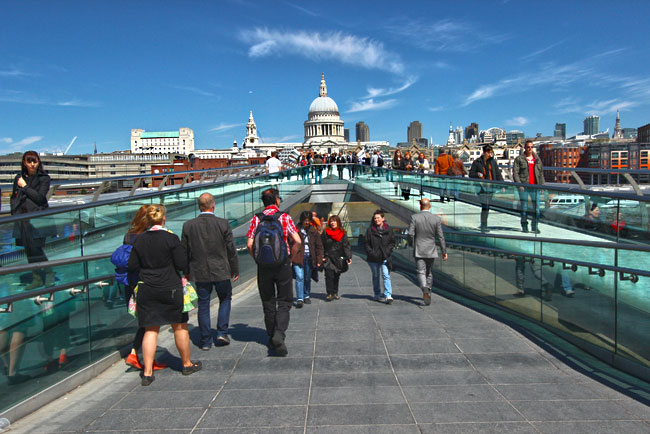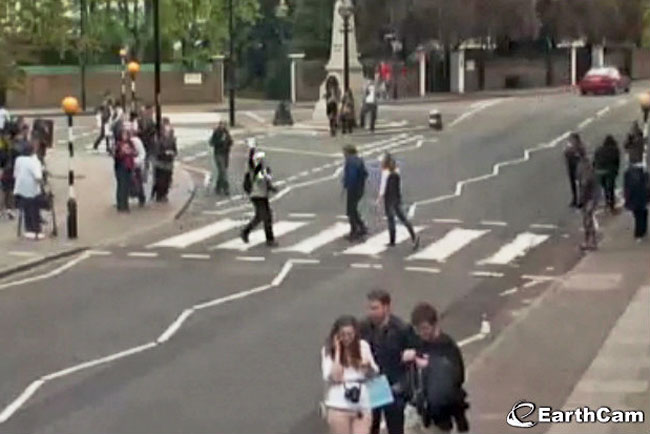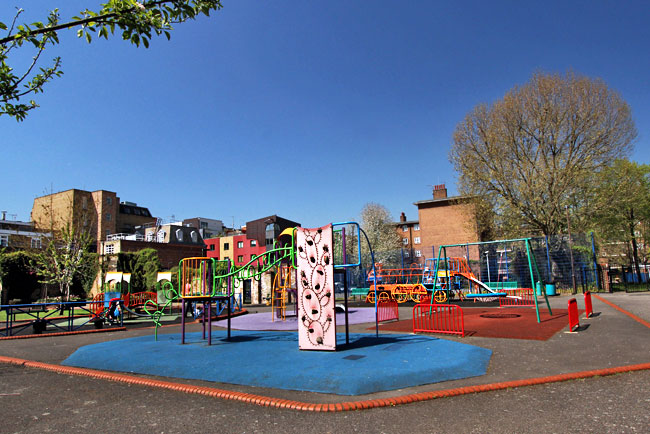During my first trip to the United Kingdom two years ago my friend and travel writing compatriot, Mike Sowden, took me on an architectural walking tour of York’s old city walls. As we neared the megalithic York Minster Cathedral, he asked what cities I had visited in England.
“Only Newcastle and here,” I said.
“You haven’t been to London yet?” he asked, astonished. “Good for you,” he added after a few moments of reflection. “So many tourists only visit London and think they’ve seen England.”

This time, I decided it was finally time to visit London and see for myself what the hype was all about. Fortunately, after a miserably long and cold winter, the sun came out on the day I arrived and stuck around for the better part of a week. Hoping to see the most important sights, I ferreted out all the most famous streets in London. Crossing over to the north shore of the Thames I meandered down to the Tower of London and Tower Bridge, then back into the financial district for a close-up view of unexpectedly avant-garde skyscrapers that dominate the skyline. St. Mary’s Axe, affectionately known by its nickname “the Gherkin” soars skyward like a giant ‘conehead.’ Just down the street, the Lloyd’s building looks for all the world like a stack of spiral-bound notebooks plunked down on a library shelf. Nearby, tourists and locals alike rubberneck at the city’s newest skyscraper, currently under construction, which features a startlingly concave, gravity-defying design.

I joined throngs of office workers in Leadenhall Market who were lifting a pint before heading home after work; strolled through St. James Park, where exotic birds gifted to the monarchy by world leaders paddle serenely around the lake; and peered at the inscrutable palace guards at a boxy, uninteresting Buckingham Palace. One whole day was devoted to exploring South Bank, a long narrow strip along the River Thames that is chockablock with tourist sights, from the giant Ferris wheel known as the London Eye to the Globe Theatre and Tate Modern Museum.

By the time I got around to the Palace of Westminster, St. Paul’s Cathedral, and Westminster Abbey on day three, I understood precisely what my friend Mike had meant. London is an exhilarating city but after a few days of sightseeing exhaustion set in. The crowds around Piccadilly Circus and Trafalgar Square were the tipping point; I had to escape from the crush of tourists and find a way to connect with locals.

I pulled out my map and began examining the small streets of the Southwark neighborhood where I was staying. Just around the corner from my hostel was a small green square labeled Little Dorrit Park. I squinted at the surrounding roads and found Clennam, Doyce, and Copperfield Streets near the intersection of Marshalsea Road and Borough High Street, as well as St. George the Martyr Church. The names were familiar; on the plane ride to London I had finished reading Charles Dickens’ novel, Little Dorrit, which featured the characters Daniel Doyce and Arthur Clennam, as well as the infamous Marshalsea debtors prison.
The next morning I set out on a self-directed Dickens discovery tour. At Little Dorrit Park I struck up a conversation with a mother whose children were scrambling over monkey bars and laughing down slides.
“You can still see a wall of the old Marshalsea Prison,” she said. “They were going to tear it down but a local group stepped in and stopped the demolition.”
I found the remnant of the old wall just across the street, pressed into service as an enclosure for the gardens at St. George Church, where the characters in Little Dorrit had been married. I sat on a wooden bench, trying to imagine the neighborhood in the days when the infamous prison still existed. Seeing the places that Dickens wrote about brought his novels to life for me, but for the author it was much more than just fiction. Dickens is often touted as a master of character development but the truth is that he wrote about the things he knew best. As a child he spent a great deal of time at Marshalsea, where his father had been imprisoned because he owed money to a local baker.

The following day I continued my quest for a more local experience when I took the London’s Rock and Roll Legends Tour. From the home of the late Freddie Mercury of Queen fame, where diehard fans still leave notes attached to the estate walls, to the Notting Hill apartment of Monika Dannemann, where Jimi Hendrix died, our tour guide took us on a no-holds-barred romp through the history of rock and roll. The coup de gras was our final stop at Abbey Road Studios, where the Beatles recorded their album of the same name. Scads of young girls took turns marching across the pedestrian crossing in front of the studio, imitating the photo of the military-like strides of the Beatles that was featured on the album cover.
“They’re way too young to remember the Beatles,” I protested to our guide who, like me, had grown up during the Beatles era.
“You’d be surprised,” he said. “A young Japanese girl on a tour last week told me more about the Beatles than I’d ever known.”
And so I joined the rest of the rock and roll pilgrims, marching across the avenue and stopping briefly in the middle of the road to wave at the street cam, knowing that I could retrieve my photo online from the AbbeyRoad.com website anytime during the ensuing 24 hours.

When it was time to leave London, I did so with mixed emotions. I was happy to escape the crowds and traffic, sad that there was so much of the city I had not seen, but pleased that I had explored some non-touristy neighborhoods where I’d had delightful conversations with regular Londoners. Had I had a month to spare, I suspect that I still would not have seen everything the city has to offer, but frankly, seven days in London is a sin and I’m already planning a return.
If you’re considering a visit to London, my favorite site for finding the best prices on accommodations is Booking.com. I earn a small sum if you book by clicking on this link to London accommodations, which helps keep this blog free for you to read.


I hate to say it, but I’ve only ever been to London, but I do know there’s a lot more to England that I’d love to see someday. I can imagine the crowds of tourists would be overwhelming, as I’ve dealt with that myself lately in other cities. But I’m glad you were able to find a good way to see other parts of the city that aren’t so heavily touristed (is that a word?) and the Dickens stuff sounds really interesting!
Love London and live part time there since 1971. I get out of town with what is called The Time Out Book of Country Walks. Not only are the 52 walks arranged by time of year ( one a week), but they begin and end at train or tube stations. Have done a few and like the idea of exploring the countryside on foot. The book also gives times to meet up with groups you connect with and has shortcuts for those of us who can do say 4 but not 9 miles. A great investment for budget travelers who want to see the countryside up close and personal.
Hi Phyllis: Thank you so much for your comment. The Time Out Book of Country Walks sounds absolutely fascinating and I’ve made a note to pick one up for my next visit to London. I love to walk – think it’s the best way to get to know a city – so it sounds perfect for me!
Great post. I’m very interested in discovering everything London has to offer.
Thanks Dan. London has so much to offer that I could return year after year and, I suspect, never see it all.
Barbara as travel bloggers who live in London, we found it interesting to read this post 🙂 We don’t blame you- the crowds in central London can be stifling at the best of times. The next time you’re here, do try to visit the open markets (especially Greenwich and Borough Market). Think you’ll enjoy those 🙂 We have some suggestions for offbeat day trips that might tempt you into coming back to London here: http://www.bruisedpassports.com/wheres/5-offbeat-and-free-day-trips-from-london.
Hi Bruised Passports: I did actually visit the Borough Market, though in the afternoon when it was all but closed up. I also spent a day at the Camden Markets/Canals, which was interesting despite the hordes of tourists. There is SO much to see and do in London that it’s almost overwhelming, specially when fighting crowds. I definitely want to come back, though I think in the shoulder season next time.
So true how typical sight seeing can be devoid of cultural experience.
Great article! Working in a large city in the UK we do most our travelling to places that are not big cities… but when we do we always walk as much of the city as we can, it’s the only true way to experience them.
I wholeheartedly agree, Liz. Walking is the way I always get a feel for a new city. Nothing beats it.
I lived in London for ten years (and live just outside it now). I found it exhausting for the first 4 years! It sounds like you managed to see a good dose of it in the time you were there but I agree with you and some of the above commenters in that it takes a long time to get to know a city as large as our world capitals. For a more local experience it can be quite fun to do some of the kookier things the city has to offer – there’s a real craze for tea dances in London at the moment and the dance halls and ballrooms are often located in the less visited parts of the city. Hope you enjoy your next visit – I love it!
Tea dances! How interesting. I didn’t even have time to experience a true high tea, so the idea sounds intriguing. I’ll have to hunt one of these down next time I’m in London, Rachel. Thanks!
There’s something called The Museum Mile in London which boasts 12 free museums along it’s length. London is clearly one of the great cities of the world. Like NYC, I think it can be a tough place to live, but there are many people, like many New Yorkers, who don’t feel totally alive if they’re away too long. I’m kind of intrigued that with all your world travel, you managed to not visit London for so long.
Hi Suzanne: It is interesting that I never visited London or Paris before the last few months, and I only made it to Rome in 2007. Seems my travels have been more focused on developing countries.
I think next time you visit maybe you should do some couchsurfing and stay with locals, outside central London in one of the neighbourhoods, then you could discover the crush of travelling in the rush hour on the tube just like the locals do!
Hi Heather – I did discover the crush of the tube during rush hour 🙂 I’ll have to give some thought to couchsurfing next time!
I’ve been here about 8 years now via Belfast, then Glasgow (the size of my home city progressively increasing). There’s a huge amount of stuff to discover in London, even in the areas where the tourists are and although at times it seems that the history’s been bulldozed in favour of skyscrapers, there’s still lots to find.
I have to stay, I’ve never been to Abbey Road, though!
Hi Julie – delighted to hear that my story about London taught you something about your adopted city!
We make an annual sojourn to London from New York to visit in-laws. I find the city actually more manageable then NYC. Having said that, it is very like NYC, and like any big city, there are neighborhoods with real people and distinct characters. Pubs are also the place to find locals. You are right about Trafalgar Square – the architecture is appalling, not to mention the tourists. But The Tate Modern deserves to be entered, and the renovation of the walkway along the Themes is lauded by locals as an important improvement that has had a positive impact on the art and culture of the city. the Top of the gherkin also offers an incredible 360 degree view of London. she your impression of London wasn’t as bad as the headline made it seem!
LOL Robin – you’re probably right about the headline being worse than the story. You read it through, so you know I really liked London, but as with any big city, where life is fast-paced and people are generally stressed, it’s a bit hard to get beneath the surface and find the true culture of a place. I suspect I’ll have to return many more times before that happens – which I undoubtedly will do.
I really enjoyed reading this article. There really is so much to explore in London beyond what most tourists think. It’s a city of so many layers. Referring to your closing about not spending enough time there, I lived in London for 3 years and feel like a barely scratched the surface. Such a great place.
Hi Paul: I grew up in a big city (Chicago) but the old adage is true – you’re never really familiar with what’s in your own backyard. I lived there for 18 years and never knew what Chicago had to offer until I left. Suspect it’s much the same for London. It’s a terrific city and I hope I visit many times and really get to know it on an intimate level.